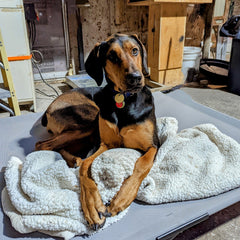Dining Room Cedarstrip by Stuart Reid, Kanata, ON, Canada
Posted on June 13 2014
By Stuart Reid
What Canadian outdoors enthusiast frequenting the back woods of Algonquin Provincial Park doesn’t want to be sporting their very own cedar strip canoe across the many wind-beaten lakes and portages? It was that mindset that inspired the creation of our beloved 16 foot eastern white cedar strip Chestnut Prospector borne out of Ted Moores, Canoecraft bible.
In the beginning, in 1991, our biggest obstacle was living in a one bedroom apartment with no tools, no room, nor regulations permitting such construction; our only solution – move into a townhouse and acquire the necessary equipment to pursue our goal.
Tool acquisition was the easy part but the townhouse presented a whole new set of challenges starting with an impossibly small, inaccessible basement window form which to export or import a canoe. The odd shaped basement stairwell presented a couple of 90-degree turns tight enough in which to get our washing machine stuck during move in. Both problems dampened our hopes of extracting any future watercraft.
What we did have however, was a 12 foot dining room with a four foot wide doorway leading into the living room, a patio door to the backyard, a complete lack of dining room furniture, and a relentless resolve to build our canoe. We had the tools at the ready in the basement family room (aka, workshop) and we now had the room on the main floor in which to begin construction. We saw no problem with the fact that our canoe extended 4 feet into the living room at it served as a constant reminder that there was a project in need of completion and a goal to be achieved.
A canoe in our dining room also served as a great conversation piece amongst guests. The underlying frame, the Strongback, even served double duty as buffet table in the early construction phases when we could actually fit people and a table in the midst of our assorted project paraphernalia. At no time did our visiting fellow outdoor enthusiasts ever question our motives or methods and we were only too happy to share the on-going saga of our construction progress.
The construction phase encompassed the winter months of 1991. In these pre-Internet shopping days hunting down all the wood, epoxy, fiberglass, sandpaper, brass, and other assorted materials required for this project was a time consuming activity. Thankfully we did find all the necessary resources including all the eastern white and western red cedar that we painstakingly stripped as well as beaded and coved in our basement workshop; the caning for the maple seats, and all the other great hardwoods for the accents: cherry and walnut decks, ash keel and gunnels. All of these fancy accents are lovely to look at but left us with an end result we didn’t fully anticipate – extra weight on the canoe – our eyes were clearly bigger than our shoulders. Through the entire process, Canoecraft was an amazing resource. No questions left unanswered as the construction process unfolded.
Construction ended the morning of our first camping trip July 26, 1991, when we were up early to cap the final details and strap our beloved craft to the top of our car. We have since taken it on many an adventure, trip, and portage in eastern Ontario and the United States. We have tripped much of the interior of Algonquin and Lady Evelyn Provincial Parks, as well the Raquette River in the Vermont Adirondacks, and the Allagash Wilderness Waterway in Maine. No matter where we went, our canoe has been a center of attention and endless questions of interest. Our adventure partners have always joked that extra time needs to be planned for a route to accommodate the inevitable delays for admirers.
One of the most challenging trips we took was on one memorable May long weekend a couple years post construction. “Passable” was the advice of a local private outfitter outside Algonquin Provincial Park when we asked the condition of Otter Creek, an eastern Park access point leading into the interior of Algonquin. I beg to differ. First and foremost, we found ourselves paddling upstream in fast flowing, shallow river ever vigilant of the rocks, other obstructions, and the ice that could potentially damage the hull. Getting out of the craft also presented a challenge as there was no real accessible shoreline and it was still ice encrusted from the past winter and yet there were times when we had to wade through the frigid waters manually pull the canoe trough and over many a shallow section. So, in a journey that should have only taken a couple of hours to complete, took up the entire day and left us cold, wet, and paddling like bats-out-of-hell when we finally hit Lower Hay Lake, and our evening’s campsite.
Through it all, adventures are all a part of camping and canoeing and we have enjoyed our fair share of them in the comfort and beauty of our Chestnut Prospector. We have our own, homemade, masterpiece of watercraft construction that will last us a lifetime. We have since passed our Strongback and hull forms on to another hopeful builder to continue the saga and stories that accompany this labor of love.
We also learned one basic and fundamental rule of interior decoration through this project: never buy a white sofa when the amount of sawdust you plan to produce in your daily living space exceeds the capacity and functionality of your average household vacuum. We ditched the sofa on one of our household moves since construction – but the canoe is still with us, being shared with the next generation.

























